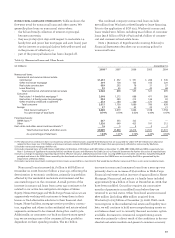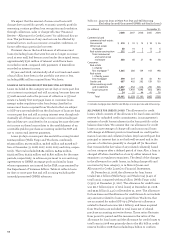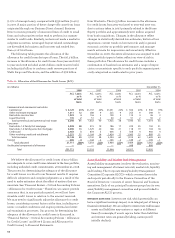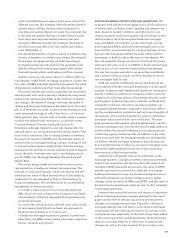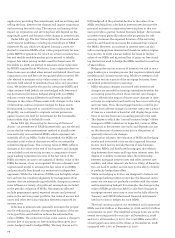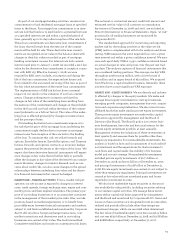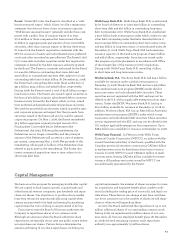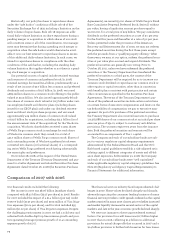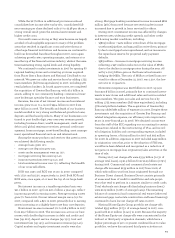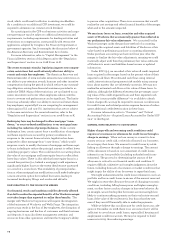Wells Fargo 2008 Annual Report Download - page 71
Download and view the complete annual report
Please find page 71 of the 2008 Wells Fargo annual report below. You can navigate through the pages in the report by either clicking on the pages listed below, or by using the keyword search tool below to find specific information within the annual report.• assets and liabilities may reprice at the same time but by
different amounts (for example, when the general level of
interest rates is falling, we may reduce rates paid on
checking and savings deposit accounts by an amount that
is less than the general decline in market interest rates);
• short-term and long-term market interest rates may
change by different amounts (for example, the shape of
the yield curve may affect new loan yields and funding
costs differently); or
• the remaining maturity of various assets or liabilities may
shorten or lengthen as interest rates change (for example,
if long-term mortgage interest rates decline sharply,
mortgage-backed securities held in the securities avail-
able-for-sale portfolio may prepay significantly earlier
than anticipated, which could reduce portfolio income).
Interest rates may also have a direct or indirect effect on
loan demand, credit losses, mortgage origination volume, the
fair value of MSRs and other financial instruments, the value
of the pension liability and other items affecting earnings.
We assess interest rate risk by comparing our most likely
earnings plan with various earnings simulations using many
interest rate scenarios that differ in the direction of interest
rate changes, the degree of change over time, the speed of
change and the projected shape of the yield curve. For exam-
ple, as of December 31, 2008, our most recent simulation indi-
cated estimated earnings at risk of less than 1% of our most
likely earnings plan over the next 12 months using a scenario
in which the federal funds rate rises to 4% and the 10-year
Constant Maturity Treasury bond yield rises to 6%.
Simulation estimates depend on, and will change with, the
size and mix of our actual and projected balance sheet at the
time of each simulation. Due to timing differences between
the quarterly valuation of MSRs and the eventual impact of
interest rates on mortgage banking volumes, earnings at risk
in any particular quarter could be higher than the average
earnings at risk over the 12-month simulation period, depend-
ing on the path of interest rates and on our hedging strate-
gies for MSRs. See “Mortgage Banking Interest Rate and
Market Risk.”
We use exchange-traded and over-the-counter interest
rate derivatives to hedge our interest rate exposures. The
notional or contractual amount, credit risk amount and esti-
mated net fair value of these derivatives as of December 31,
2008 and 2007, are presented in Note 16 (Derivatives) to
Financial Statements. We use derivatives for asset/liability
management in three main ways:
• to convert a major portion of our long-term fixed-rate
debt, which we issue to finance the Company, from fixed-
rate payments to floating-rate payments by entering into
receive-fixed swaps;
• to convert the cash flows from selected asset and/or liabil-
ity instruments/portfolios from fixed-rate payments to
floating-rate payments or vice versa; and
• to hedge our mortgage origination pipeline, funded mort-
gage loans and MSRs using interest rate swaps, swaptions,
futures, forwards and options.
MORTGAGE BANKING INTEREST RATE AND MARKET RISK We
originate, fund and service mortgage loans, which subjects us
to various risks, including credit, liquidity and interest rate
risks. Based on market conditions and other factors, we
reduce unwanted credit and liquidity risks by selling or secu-
ritizing some or all of the long-term fixed-rate mortgage
loans and ARMs we originate. On the other hand, we may
hold originated ARMs and fixed-rate mortgage loans in our
loan portfolio as an investment for our growing base of core
deposits. We determine whether the loans will be held for
investment or held for sale at the time of commitment. We
may subsequently change our intent to hold loans for invest-
ment and sell some or all of our ARMs or fixed-rate mortgage
loans as part of our corporate asset/liability management.
We may also acquire and add to our securities available for
sale a portion of the securities issued at the time we securi-
tize mortgages held for sale.
2008 was another challenging year for the financial ser-
vices industry with the continued deterioration in the capital
markets, widening credit spreads and significant increases in
market volatility, in addition to changes in interest rates dis-
cussed in the following sections. Notwithstanding the contin-
ued downturn in the housing sector, and the continued lack
of liquidity in the nonconforming secondary markets, our
mortgage banking revenue continued to be positive, reflect-
ing the complementary origination and servicing strengths of
the business. The secondary market for agency-conforming
mortgages functioned well for most of the year. The mort-
gage warehouse and pipeline, which predominantly consists
of prime mortgage loans, was written down by $584 million in
2008 to reflect the unusual widening in nonconforming and
conforming agency market spreads. In addition to the write-
down associated with the mortgage warehouse and pipeline,
we further reduced mortgage origination gains by $234 mil-
lion in 2008 primarily to reflect an increase to the repurchase
reserve for higher projected losses due to the continuing
deterioration in the housing market.
Interest rate and market risk can be substantial in the
mortgage business. Changes in interest rates may potentially
impact total origination and servicing fees, the value of our
residential MSRs measured at fair value, the value of MHFS
and the associated income and loss reflected in mortgage
banking noninterest income, the income and expense associ-
ated with instruments (economic hedges) used to hedge
changes in the fair value of MSRs and MHFS, and the value of
derivative loan commitments (interest rate “locks”) extended
to mortgage applicants.
Interest rates impact the amount and timing of origination
and servicing fees because consumer demand for new mort-
gages and the level of refinancing activity are sensitive to
changes in mortgage interest rates. Typically, a decline in
mortgage interest rates will lead to an increase in mortgage
originations and fees and may also lead to an increase in ser-
vicing fee income, depending on the level of new loans added
to the servicing portfolio and prepayments. Given the time it
takes for consumer behavior to fully react to interest rate
changes, as well as the time required for processing a new








